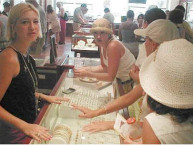Cameos
 When one thinks of Cameo the first thing that pops into ones head is “Oh, those are those little pieces of jewelry that old ladies wear at their neck with the outline of women’s faces.” Very few wonder about the artwork or even what material is used in creating cameos. We see them often at art auctions and casually pass them by. We do notice however that some collectors are quickly snapping these pieces up. Why? Are they made with some terribly expensive material? Is there something we are missing?
When one thinks of Cameo the first thing that pops into ones head is “Oh, those are those little pieces of jewelry that old ladies wear at their neck with the outline of women’s faces.” Very few wonder about the artwork or even what material is used in creating cameos. We see them often at art auctions and casually pass them by. We do notice however that some collectors are quickly snapping these pieces up. Why? Are they made with some terribly expensive material? Is there something we are missing?
What does the word Cameo mean? It literally means “raised above.”
Lets look at the history of Cameo.
The earliest known engraved stone, as far back as 15,000 BC, were petroglyphs, scratched into rock to record and communicate. These developed into ideographs – symbols representing ideas, and pictographs, which recorded events in picture form. Writing and all other art forms developed from these early recording skills.
The next step towards the cameo was the seal, examples of which have been found from 3,000 to 4,000 BC. Made from a variety of materials, including wood, ivory and stone, the inscribed, or intaglio, design was pressed onto soft clay or wax, to seal a letter, cask, jug, or doorway. As long as the seal was unbroken, the contents were seen to be safe. The seal itself was worn as an amulet, or charm, for good luck, and to protect against evil.
The most well known ancient seal is the Egyptian scarab. The image of the beetle was carved on the domed top of the stone, and the flat base engraved with symbols of luck and good fortune, prayers for the dead, spells and names. Ancient scarabs were carved from soapstone, alabaster, and serpentine. Later they were made from faience, which is soapstone and powdered quartz, with a fired glaze made from copper compounds. Only when grinding tools were constructed were they made from the harder chalcedony, cornelian and onyx.
The art form found its way from Egypt, through Assyria and into the Mediterranean countries through trade. Although the Egyptian craftsmen were productive, there was little creativity in their work. The Phoenicians, Etruscans, Greeks and Romans developed the art of gem engraving to the point that their seals became collectors’ items.
The Mycenaean civilization in Greece, Crete and Cyprus refined the craft to a high standard, but in the 12th century BC Mycenae fell, and the art of carving gemstones declined and was nearly lost. Revived by the Greeks between the 11th and 8th centuries BC, the scaraboid, a plain topped semi-oval, engraved only on the flat underside, appeared, at first crudely made. The craftsmen did not have the ancient Egyptian grinding tools, and had to work the hard stones by hand.
By the Golden Age of Greek classical art, from the 5th to the 4th centuries BC, the engravers had surpassed the skills of the Mycenaean culture. They worked in hard precious and semi-precious stones, choosing them for their colour and the ability to transmit light. They used, amongst others, chalcedony, jasper, cornelian, turquoise, and malachite.
Then, in the 3rd and 2nd century BC, the cameo, a carving in relief, was developed because of the introduction of many colored, multi layered sardonyx from India and Arabia, at first thought to be synthetic. The cameo made a picture in the lighter, upper layers of the stone, standing out boldly from the lower darker layers. They used simple belt driven drills, carving finer details with hand held bronze or iron gravers.
Although ancient myths and legends were still used as subjects, the portrait now found its way into the repertoire of the cameo sculptor. However, famous men, such as Alexander the Great, were depicted as classical gods, and their real likenesses are unrecorded. As with any art, the talents of the artists varied, and there were good and bad examples of cameo and intaglio carvings, some of which were made as jewelry.
A most remarkable piece of bas-relief work in sardonyx is the Farnese Cup, named after the family who acquired it in the fifteenth century. Made about 150 years before the birth of Christ, probably symbolizing the bounty of the Nile Valley, its finer interpretation is still debated. Under the cup is depicted the head of the Gorgon Medusa, with snakes in her hair. It was said that such a likeness on a plate or cup prevented death by poison.
After the death of Alexander the Great, the shift of power moved from the Greeks to the Romans, and much of Greek art, literature and philosophy became part of the Roman culture. Many rich Romans had Greek slaves who were skilled lapidaries, or stone and gem carvers, and encouraged them to use their skills. The art of cameo carving became much more important, and cameos were widely used in rings and jewelry, as well as larger ones as portraits and to decorate wealthy homes.
Hundreds of Greek artisans came to Italy to satisfy the desire for cameos of all kinds. Again, artisans were not equally skilled, and all degrees of craftsmanship, from master to mediocre can be seen in the cameos of this era. Fine examples of the art from that time are the Gemma Augusta, carved to honor the Emperor Augustus, and the Grand Camee de France, carved by Dioskourides in 25 BC, measuring 13 by 9 inches.
Then came the Dark Ages, when Rome and the ancient civilizations fell to conquering barbarians. The Christian religion discouraged idolatry, which included works of art, especially sculptures, and as Christians did not bury precious items with their dead, their early art was mostly lost. The dark age of cameo carving began, knowledge was lost again, and training in the arts denied.
Some creative skills were retained through the monks, and carvings began to appear again on diptychs and triptychs, two and three carved panels of wood and ivory. These were mostly religious. From the Renaissance onwards there was a new interest in classicism, and all the ancient myths and legends were again used as subjects for the carver.
Gradually, the ancient skills were redeveloped, and it is thought that seaman from around the Bay of Naples took to carving on shells during long sea voyages, similar to scrimshaw carving on whalebone, so beginning the tradition of carving cameos in sea shell, which had the required layered structure.
In England, Elizabeth the First is supposed to have introduced the custom of giving a cameo pendant or brooch as a gift to a loyal subject. The popularity of the cameo reached a climax in the 18th century and artists from all over the world went to receive instruction from the Roman and Florentine masters. Fraudulent copies of masters were made, and mass production again brought a poorer quality of carving. Queen Victoria was known for her love of cameos, and during her reign, their popularity peaked again.
 So to today, and fine cameos are again becoming sought after as items of jewelry. There are fewer master carvers, and the young Italians do not turn to learning the ancient craft as readily as before. There are still many beautiful cameos available, but sadly, many more that are mass produced for a cheap tourist trade.
So to today, and fine cameos are again becoming sought after as items of jewelry. There are fewer master carvers, and the young Italians do not turn to learning the ancient craft as readily as before. There are still many beautiful cameos available, but sadly, many more that are mass produced for a cheap tourist trade.
Sadly, fewer and fewer young people choose to be apprenticed into the trade, although The State Institute of Art in Torre del Greco still offers training in the art of engraving and cameo cutting. The first year student practices with mosaics, By the third year the student can proficiently carve a flower, and by the final year the student is mastering the cutting of a Botticelli head in cameo.
Two sea shells are most frequently used – the cassis rufa, giving a creamy relief against a pinky brown background, and the larger cassis madagascariensis, with a dark pinky brown background and a whiter relief. Some pink cameos can be found using the strombus gigas shell, but they are not as common.
These shells have three layers. The outside layer, warty in appearance is usually cleared away, unless used for special effect. The middle layer is white or cream, and is the layer in which the design is carved. The third, interior, layer provides the contrasting color against which the design is shown in relief. Shells unsuitable for traditional carving are sold as mementoes, with a rough carving on the whole shell.
Only part of the shell is used for carving. A skilled operator cuts away the unwanted part, using a steel saw , with water constantly spraying to keep the blade cool. Then ovals, from 6mm in length, are cut from the best colored pieces, roughly smoothed and trimmed by grinding wheel, and finished by hand.
The oval is then attached to a dopstick with shellac, and the hand carving begins, at first with a small hand drill to make a rough outline, then with a steel graver for the fine detail. As more and more detail is added, the carver uses progressively finer points. Each cameo design has to take into account all the depressions and protuberances on the shell, with no two exactly alike. No machine can replicate this skill, so every shell cameo is genuinely hand carved and unique.
The carved pieces of shell are then individually hand mounted in a variety of frames to make earrings, rings, bracelets, brooches and pendants. The cost of any cameo depends upon the size, quality and type of shell, the style and carat of the setting and the expertise of the carver.
The time involved in crafting a hand-carved Cameo is about 4 to 7 days depending on how intricate. While a cameo carving automated machines can put out about 5 Cameos per workday. How can one tell the difference between a hand carved Cameo and a machine crafted item? The hand carved item will be more detailed and in most cases will have an imperfection or two. Most imperfections will not be readily noticeable to the non trained observer, but they will be noted by a trained evaluator.
When you are looking at Cameos bring along a loop of at least 10X magnification. You may also need to examine it under a microscope with a strong light to expose any cracks or breaks in the material. Take your time with each piece and it will “speak” to you.
What factors determine the Value of a modern Cameo? You will want to evaluate the material that the Cameo is carved from. Is it one piece or is it a composite? Shell is less valuable than hardstone. Is it of natural color or has it been dyed or enhanced? Check the detail of the piece. Hair should appear natural, if you are able to distinguish individual strands this is a highly detailed piece. The more detail, the more value. Is the piece signed by the artist? Many carvers are very creative with where they place their signatures. Some collectors concentrate on pieces where the artist blends his signature into the strands of hair. Some artist merely sign the back.
You will find that the better artists generally use high quality stones on which to engrave their cameos. They will be very detailed and finely balanced.
Collectors tend to have fun with Cameos. Some will collect group scenes, children, or of women who are facing the left. Some collect only one material such as agate or shell.
“What about Antique Cameos, what do you look for?” Many feel that period of origin is the most important factor, while others feel that the depth of the carving is most important. This is one item which thru-out history went thru huge changes, in regards to fashion, politics, and education of the owner. They are probably the one piece of Jewelry that is a fascinating timeline for mankind.
MYTHS AND LEGENDS
Classical Greek and Roman mythology has been an inspiration for cameo carvers for centuries. Most of the ancient Greek stories were taken into the Roman mythology, sometimes with subtle alterations and additions. These differences can cause great difficulty in the interpretation of some traditional carvings, and often the true meanings die with the artist.
Some of the everyday profiles that abound have their origins in the portrayal of deities, even if they have only retained a symbol, such as a dove, (Aphrodite) a moon, (Diana) or a flower, (Flora). All the deities had their own personal emblems, or attributes.
The following are some of the ancient gods and goddesses that are the favorite choices of ancient and modern carvers alike. Most can be found depicted on cameos in the Di Cara Collection.
Zeus, (Jupiter) King of the Olympian gods, and his wife, Hera (Juno), Apollo, god of music, Ares (Mars), god of war, Aphrodite (Venus) goddess of Love , her son Eros (Cupid), god of love, Eos (Aurora), goddess of the dawn, Demeter (Ceres), goddess of the harvest and fertility, Dionysus (Bacchus), the God of wine and fertility, with his followers , the Bacchanales, and Artemis (Diana), goddess of hunting and childbirth. Other minor deities and beings such as The Vestal Virgins, Tyche (Fortuna), Leda, Daphne and Hebe can also often be found in modern cameos. (Roman names are given in brackets)
The frescoes that abound in the unearthed ruins of Pompeii and Herculaneum also provide subjects for the carvers’ art. Scenes from Ancient Pompeii and cherubs or putti taken from these frescoes can be found on many cameos. Famous paintings were often copied, in whole, or part, such as The Last Supper by Leonardo da Vinci, or Boticelli’s The Birth of Venus, and Primavera (Spring): from the last, the detail of the Three Graces is often taken. The carver Cirillo produces exquisitely detailed cameos, as small as 35mm oval, after the work of the French artist Boucher.
Victorian cameos were often thought to hold some message for, or attribute of, the recipient, such as Lover of Music. Sometimes a cameo is just the expression of the innermost feelings of the artist, and, like any work of art, its interpretation and appreciation is in the eye and mind of the beholder.
Cameos are made from fragile pieces of shell, and can be cracked or broken if treated roughly. The frames are usually fairly light so that they do not detract from the beauty of the cameo, and so that the finished item of jewelry is not and heavy to wear. The frame will, however, provide a considerable amount of support for the shell.
Cameos become grubby with wear, and can be gently cleaned with a soft brush and warm soapy water. Swill with clean water, and dab dry with a lint free cloth. Shell can dry out, and the color and shine can be restored by rubbing in a drop of clear oil, such as sewing machine lubricating oil, or olive oil. Never be tempted to varnish the cameo.
 Before cleaning Before cleaning |
 After Cleaning After Cleaning |



